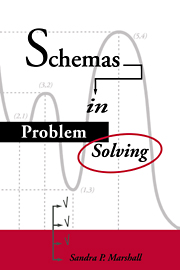Book contents
- Frontmatter
- Contents
- Preface
- Acknowledgments
- I Fundamentals
- II Schemas and instruction
- 4 Theoretical issues for instruction
- 5 The Story Problem Solver and The Problem Solving Environment: Two examples of schema-based instruction
- III Learning from instruction
- IV Schemas and assessment
- V Schema models
- Notes
- References
- Name index
- Subject index
5 - The Story Problem Solver and The Problem Solving Environment: Two examples of schema-based instruction
Published online by Cambridge University Press: 22 October 2009
- Frontmatter
- Contents
- Preface
- Acknowledgments
- I Fundamentals
- II Schemas and instruction
- 4 Theoretical issues for instruction
- 5 The Story Problem Solver and The Problem Solving Environment: Two examples of schema-based instruction
- III Learning from instruction
- IV Schemas and assessment
- V Schema models
- Notes
- References
- Name index
- Subject index
Summary
The Story Problem Solver (SPS) is a computer-implemented program of instruction about arithmetic story problems. My research group and I developed SPS as an explicit instructional test of schema theory. Its companion, the Problem Solving Environment (PSE), is also a computer-based system, one that provides no additional instruction but that serves instead as a practice arena in which we can evaluate students' acquisition of schema knowledge. Both SPS and PSE are written in Lisp and run on Xerox 1186 computer workstations equipped with 19-inch display monitors and three-button optical mice. In this chapter, I first describe SPS and its instructional objectives and then explain the contributions of PSE.
The primary instructional objective for SPS is to assist students in creating schemas that are based on the five situations described in detail in chapter 3: Change, Group, Compare, Restate, and Vary. My purpose in developing SPS was to construct a series of lessons that reflected the basic knowledge components of a set of schemas, that allowed direct assessment of those components, and that resulted in students' creation of the specified schemas.
SPS consists of a set of 28 distinct lessons, with one or more specific exercises following each lesson. The lessons are designed to last from a few minutes to a full half hour, with the actual length of interaction dependent to some extent on the individual student's level of skill and attention. The system is fully operational and has been used by almost 150 students.
- Type
- Chapter
- Information
- Schemas in Problem Solving , pp. 128 - 168Publisher: Cambridge University PressPrint publication year: 1995

